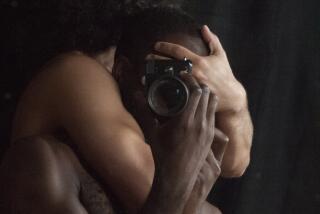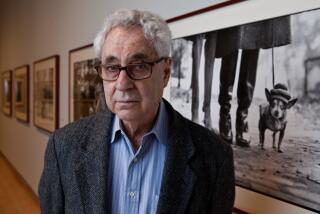Images From His Life in Pictures : Photographer: Alfred Eisenstaedt’s work shows his tireless curiosity and the real genius behind the lens.
- Share via
Legendary photojournalist Alfred Eisenstaedt died Thursday of cardiac arrest at the age of 96. He is remembered here by two friends: Times Arts Editor Emeritus Charles Champlin, who worked on assignments with the photographer at Life, and fellow photojournalist Carl Mydans, who had worked side by side with Eisenstaedt at Life since 1936, the year that both joined the celebrated pictorial magazine.
*
When Life magazine was first formed, nearly 60 years ago, and Alfred Eisenstaedt was hired as one of the first four photographers on the staff, the editors soon learned that Eisie would never grumble when an assignment was given him that some others on the new magazine might think was below their dignity. Whatever stories he was asked to cover caught his interest. “Even,” he once said, “if I was asked to photograph a dog on a leash doing his business on Fifth Avenue. When I was on assignment, my eye and my curiosity took over, and I would try to show something that showed both individuality and universality.”
In my judgment, Eisie’s great picture collection, which had grown from his photographs taken more than 70 years ago and ended shortly before he died, is one of the most important and diverse one-man collections in the world. It is the product both of his driving curiosity and his creative genius.
Eisie’s subjects were anything and anywhere. He did not always seek them out. Sometimes they just happened and he was there. And his reaction was immediate. He was a small man with unobtrusive ways who used a small, unimpressive camera, and he did not intimidate those whom he photographed but caught their essence and their actions almost as though by accident. But there was no accident in his genius.
*
Although events in Hitler’s Germany drove him out of his own country, he quickly found himself a new home in the United States.
“I was 27 years old when I came here,” he told me. “And I knew very little English but almost immediately, when I arrived, I felt something. I still feel it. I have no explanation for it, but for myself I simply think of it as ‘America.”’
The heart of his interest, other than photography, was the English language. And although he never managed to outgrow his German accent, he was absorbed in reading and studying in English. When he was not taking pictures or editing negatives, he was reading and often interrupted his thought to exclaim to anyone near him that he had found a mistake in grammar or spelling.
In the 23 years since his wife, Kathy, died, his sister-in-law, Lucy Kaye, had looked out for his needs as the years began to take their toll on his health. “Lulu,” as she was known to everyone who knew Eisie, helped him through the progressive demands and indignities of age as he grew older, wheeling him in a wheelchair down the avenue to his office in the Time / Life building after his legs gave out, staying with him each time he was taken to the hospital, supervising his move each summer to Martha’s Vineyard, where the exhibitions of his photographs were legendary. And she was with him there, and helping at the end, when his heart at last gave out.
Eisie was unique and no one will ever match the genius with which he took such memorable pictures with his little Leicas, always unassuming in his approach to his subjects, always seeming to work without effort to produce some of the most telling photographs of the men and women--famous and unknown--who crossed his path.
More to Read
The biggest entertainment stories
Get our big stories about Hollywood, film, television, music, arts, culture and more right in your inbox as soon as they publish.
You may occasionally receive promotional content from the Los Angeles Times.










